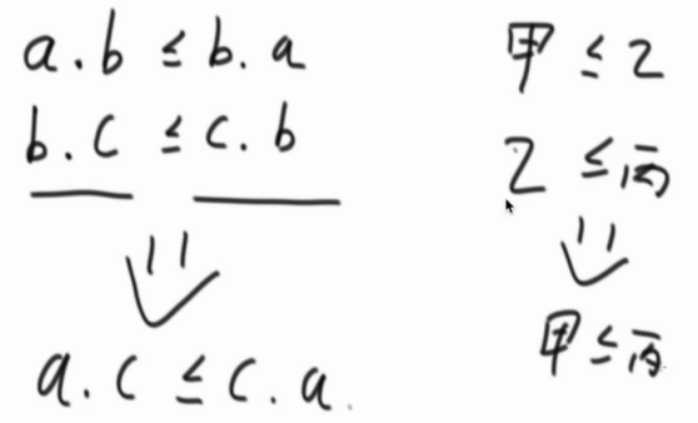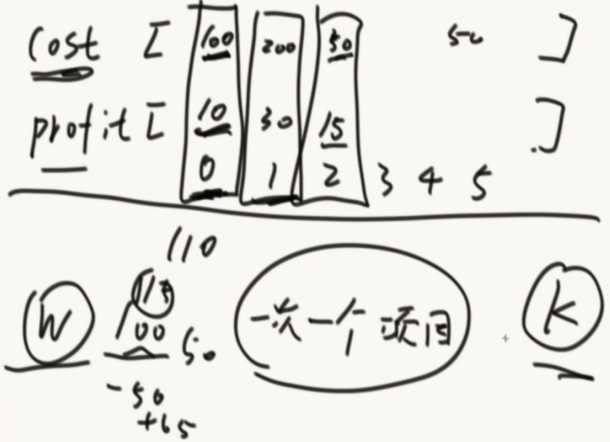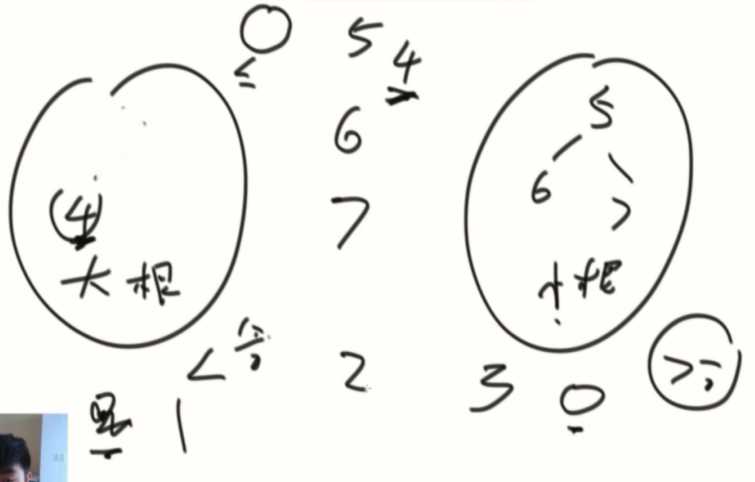标签:abc inf toc dom ali Oday one style ber
第六课主要介绍图,不经常考,故今天先讲第七课的内容,介绍比较常考的树和贪心算法
何为前缀树? 如何生成前缀树?

可以查有多少个字符串以“be”为前缀。
如果要判断有没有“be”这个节点,每个节点上加上一个数据项,有多少个字符串以当前节点结尾的(可以查加了多少次特定字符串)。

给一个字符串、返回多少个字符串以这个为前缀。
再加一个数据项,记录该节点被划过多少次。

大概实现:

删除逻辑:
根据path是否变为0,来判断是否继续往下删。

可以解决以下问题:
一个字符串类型的数组arr1,另一个字符串类型的数组arr2。
arr2中有哪些字符,是arr1中出现的?请打印
arr2中有哪些字符,是作为arr1中某个字符串前缀出现的?请打印
arr2中有哪些字符,是作为arr1中某个字符串前缀出现的?请打印arr2中出现次数最大的前缀。
public class Code_01_TrieTree { public static class TrieNode { public int path;//多少个到达过节点 public int end;//多少个以这个节点结尾 public TrieNode[] nexts;//表示下一个节点的情况 public TrieNode() { path = 0; end = 0; //26个字母 nexts = new TrieNode[26]; } } public static class Trie { private TrieNode root; public Trie() { root = new TrieNode(); } public void insert(String word) { if (word == null) { return; } char[] chs = word.toCharArray(); TrieNode node = root; int index = 0; for (int i = 0; i < chs.length; i++) { index = chs[i] - ‘a‘;//a index 0 -- b index 1 -- ...字母对应的 if (node.nexts[index] == null) {//没有路就新建出来 node.nexts[index] = new TrieNode(); } node = node.nexts[index]; node.path++; } node.end++; } public void delete(String word) { if (search(word) != 0) { char[] chs = word.toCharArray(); TrieNode node = root; int index = 0; for (int i = 0; i < chs.length; i++) { index = chs[i] - ‘a‘; if (--node.nexts[index].path == 0) { node.nexts[index] = null; return; } node = node.nexts[index]; } node.end--; } } public int search(String word) { if (word == null) { return 0; } char[] chs = word.toCharArray(); TrieNode node = root; int index = 0; for (int i = 0; i < chs.length; i++) { index = chs[i] - ‘a‘; if (node.nexts[index] == null) { return 0; } node = node.nexts[index]; } return node.end; } public int prefixNumber(String pre) { if (pre == null) { return 0; } char[] chs = pre.toCharArray(); TrieNode node = root; int index = 0; for (int i = 0; i < chs.length; i++) { index = chs[i] - ‘a‘; if (node.nexts[index] == null) { return 0; } node = node.nexts[index]; } return node.path; } } public static void main(String[] args) { Trie trie = new Trie(); System.out.println(trie.search("zuo")); trie.insert("zuo"); System.out.println(trie.search("zuo")); trie.delete("zuo"); System.out.println(trie.search("zuo")); trie.insert("zuo"); trie.insert("zuo"); trie.delete("zuo"); System.out.println(trie.search("zuo")); trie.delete("zuo"); System.out.println(trie.search("zuo")); trie.insert("zuoa"); trie.insert("zuoac"); trie.insert("zuoab"); trie.insert("zuoad"); trie.delete("zuoa"); System.out.println(trie.search("zuoa")); System.out.println(trie.prefixNumber("zuo")); } }
贪心策略正确性的证明,千万不要纠结,因为纠结你能死去。
想练贪心,记贪心的点就够了,写对数器的方式来验证。
不用去纠结哪个策略,证明上哪个是对的。这是一个大套路。
字典序介绍
例如abc和bce对比,想象成26进制的数进行对比。
长度不等的时候,把短的后面扩长来对比,后补最小的单位。


题目:给定一个字符串类型的数组strs,找到一种拼接方式,使得把所有字符串拼起来之后形成的字符串具有最低的字典序。

什么叫做贪心?
定义一个指标,在这个指标下,把每一个样本分出一个优先来,按照优先大的先执行,优先小的后执行,这就是贪心。
贪心就是一件事情,贪心就是某一种简洁的标准,在这个标准下把所有东西分出个一二三来,然后根据这个优先级,决定一种顺序,就是贪心。
贪心案例:
贪心就是找距离目标最近的拿,不管最终的结果,只注重局部或者眼前的结果的方法
按照这种方法就是有可能丧失全局最优的
就好比两个人分5个大饼,一次可以拿一个或者两个,不吃完不允许再拿
A:用贪心方法:第一次拿两个,B拿一个,那么B最终拿3个
这个就是贪心方法失败的一个例子
有的时候贪心算法也是可以得到最优解的,比如还是大饼的例子,但是现在总数是7个了
A继续贪心,先两个,再两个就是4个了;
而B先1个,后2个,就只能是3个
介绍完贪心就回到题目:
如果对数组进行排序,再拼接一起,那是不行的。

正确的排序策略:
str1做前缀str2跟后面。和相反着对比。(每个字符串作为前缀贴在一起比较)

排序策略不成立的例子。
比较策略没有传递性,是一个环。

有传递性是:

这个题比较策略就是贪心策略。要确定的一件事情,排序策略是有传递性的。
把a.b看做成K进制的数,“abc” “efg” abcefg,其实就是abc向左移动了b这个数的长度位,再加入efg。

等式两边减b乘c,第二个式子减b乘a
然后再化简。
展开后ac抹掉,同时除与b,a移过去右,c移过去左...
证明排序策略是有传递性,是一个对的排序:

还要证明用这种排序策略得到的序列,就是字典序最小的。
先证明一件事情,序列里面任意调换两个字符串的顺序后,都会产生更大的字典序。
由于传递性:a.m1<=m1.a

一路下去,然后紧贴着b,b再和a交换。一路下来都是大于等于,那么肯定就只有比原始序列大。(所以原始序列是最经济的)

这是一个贪心策略从提出策略,到证明正确,要付出较大的心血。
所以用对数器来验证他对不对即可。
题目实现代码:
public class Code_05_LowestLexicography { public static class MyComparator implements Comparator<String> { @Override public int compare(String a, String b) { return (a + b).compareTo(b + a); } } public static String lowestString(String[] strs) { if (strs == null || strs.length == 0) { return ""; } //按照对比器排序 Arrays.sort(strs, new MyComparator()); String res = ""; for (int i = 0; i < strs.length; i++) { res += strs[i]; } return res; } public static void main(String[] args) { String[] strs1 = { "jibw", "ji", "jp", "bw", "jibw" }; System.out.println(lowestString(strs1)); String[] strs2 = { "ba", "b" }; System.out.println(lowestString(strs2)); } }
一块金条切成两半,是需要花费和长度数值一样的铜板的。比如长度为20的 金条,不管切成长度多大的两半,都要花费20个铜板。一群人想整分整块金 条,怎么分最省铜板?
例如,给定数组{10,20,30},代表一共三个人,整块金条长度为 10+20+30=60. 金条要分成10,20,30三个部分。 如果, 先把长度60的金条分成10和50,花费60 再把长度50的金条分成20和30,花费50 一共花费110铜板。
但是如果, 先把长度60的金条分成30和30,花费60 再把长度30金条分成10和20,花费30 一共花费90铜板。输入一个数组,返回分割的最小代价。
标准的哈夫曼编码问题
子节点合并在一起的代价,是加起来的和。
最终要把所有的叶节点,生成一棵树。

把数组变为小根堆,然后从堆里面取出两个组成树,在把组成的父结点,放入堆中...(如此反复)最后代价就是产生的所有非叶节点。(贪心算法,每次从小根堆里面拿最小的)

顺序是从上面往下面切割。

当这种代价,是有子代价累加/乘,一种累什么的,也可能给一个公式,这都有可能用哈夫曼编码贪出来。
要具备起概念思想,用到其他的题目中。
public class Code_02_Less_Money { public static int lessMoney(int[] arr) { //优先队列是小根堆 PriorityQueue<Integer> pQ = new PriorityQueue<>(); for (int i = 0; i < arr.length; i++) { pQ.add(arr[i]); } int sum = 0; int cur = 0; while (pQ.size() > 1) { cur = pQ.poll() + pQ.poll(); sum += cur; pQ.add(cur); } return sum; } public static class MinheapComparator implements Comparator<Integer> { //输入参数的顺序都为 5 3 //如果返回 正数(证明后面的比较小) 第二个参数排在前面 5 - 3 = 2 3排在前面 //如果返回 负数(证明后面的比较大) 第一个参数排在前面 3 - 5 = -2 5排在前面 //0代表两个东西一样大 //总结:负一、正二(解决的是哪个参数排在前面) @Override public int compare(Integer o1, Integer o2) { return o1 - o2; // < 0 o1 < o2 负数 } } public static class MaxheapComparator implements Comparator<Integer> { //等于是-(o1-o2) = o2 - o1 @Override public int compare(Integer o1, Integer o2) { return o2 - o1; // < o2 < o1 } } public static void main(String[] args) { // solution int[] arr = { 6, 7, 8, 9 }; System.out.println(lessMoney(arr)); int[] arrForHeap = { 3, 5, 2, 7, 0, 1, 6, 4 }; // min heap PriorityQueue<Integer> minQ1 = new PriorityQueue<>(); for (int i = 0; i < arrForHeap.length; i++) { minQ1.add(arrForHeap[i]); } while (!minQ1.isEmpty()) { System.out.print(minQ1.poll() + " "); } System.out.println(); // min heap use Comparator PriorityQueue<Integer> minQ2 = new PriorityQueue<>(new MinheapComparator()); for (int i = 0; i < arrForHeap.length; i++) { minQ2.add(arrForHeap[i]); } while (!minQ2.isEmpty()) { System.out.print(minQ2.poll() + " "); } System.out.println(); // max heap use Comparator PriorityQueue<Integer> maxQ = new PriorityQueue<>(new MaxheapComparator()); for (int i = 0; i < arrForHeap.length; i++) { maxQ.add(arrForHeap[i]); } while (!maxQ.isEmpty()) { System.out.print(maxQ.poll() + " "); } } }
输入: 参数1,正数数组costs 参数2,正数数组profits 参数3,正数k 参数4,正数m
costs[i]表示i号项目的花费 profits[i]表示i号项目在扣除花费之后还能挣到的钱(利润) k表示你不能并行、只能串行的最多做k个项目 m表示你初始的资金
说明:你每做完一个项目,马上获得的收益,可以支持你去做下一个 项目。
输出: 你最后获得的最大钱数。
两个数组cost和profit,通过下标列出每个项目的花费和利润,做完项目后所得是cost+forfit,假设有资金W,一次只能做一个项目,最多做K个项目。输出获得最大的钱数。
贪心策略。

首先项目类型包括花费和利润,再根据花费放入小根堆中,然后看初始资金,在小根堆里面依次弹出头部,只要花费比W低的全部弹出。然后根据收益放入大根堆中,然后做大根堆的第一个项目。
当初始资金增加了,再看看小根堆中哪些项目可以做的,继续扔到大根堆中。一直做K个结束(或者大根堆里面没项目可做)。

public class Code_03_IPO { public static class Node { public int p; public int c; public Node(int p, int c) { this.p = p; this.c = c; } } public static class MinCostComparator implements Comparator<Node> { @Override public int compare(Node o1, Node o2) { return o1.c - o2.c; } } public static class MaxProfitComparator implements Comparator<Node> { @Override public int compare(Node o1, Node o2) { return o2.p - o1.p; } } public static int findMaximizedCapital(int k, int W, int[] Profits, int[] Capital) { Node[] nodes = new Node[Profits.length]; for (int i = 0; i < Profits.length; i++) { nodes[i] = new Node(Profits[i], Capital[i]); } PriorityQueue<Node> minCostQ = new PriorityQueue<>(new MinCostComparator()); PriorityQueue<Node> maxProfitQ = new PriorityQueue<>(new MaxProfitComparator()); for (int i = 0; i < nodes.length; i++) { minCostQ.add(nodes[i]); } for (int i = 0; i < k; i++) { //先把能做的项目存在大根堆中 while (!minCostQ.isEmpty() && minCostQ.peek().c <= W) { maxProfitQ.add(minCostQ.poll()); } if (maxProfitQ.isEmpty()) { return W; } W += maxProfitQ.poll().p; } return W; } }
一个数据流中,随时可以取得中位数(之前讲过,初级2 020143)
不用堆的话,就用一个容器,吐出一个数就装一个,因为无序的所以装的时候也是无序的。当想要中位数的时候,要排个序,牺牲大。

准备两个堆,一个大根堆一个小根堆。
第一个数进入大根堆,下一个数小于等于就进大根堆。
如果从大根堆弹出一个数,就拿最后的一个数和第一个数交换,然后heapsize界限-1。

看题目怎么做:
先把数加入到大根堆中,如果发现两个堆大小差值超过了1,就把较大的弹出一个放到另外一个去。
如果要查中位数,大根堆堆顶和小根堆堆顶肯定能计算出来,因为
大根堆收集了较小的2分之N个,堆顶是其中的最大值。
小根堆收集的是较大的2分之N个,堆顶是其中的最小值。
正好卡在中间的位置。
只要当前数不是小于等于大根堆的,就扔到小根堆中。
策略是固定的:
1、如果当前数小于等于大根堆的堆顶,到大根堆,否则小根堆
2、不平衡了拿出扔到少的堆里面。
这样随时可以拿到中位数。
堆很好用(调整只和层数相关、o(logn)),几乎搞定所有贪心的题目。(面试也经常考)
优先级队列就是堆。


public class Code_04_MadianQuick { public static class MedianHolder { private PriorityQueue<Integer> maxHeap = new PriorityQueue<Integer>(new MaxHeapComparator()); private PriorityQueue<Integer> minHeap = new PriorityQueue<Integer>(new MinHeapComparator()); private void modifyTwoHeapsSize() { if (this.maxHeap.size() == this.minHeap.size() + 2) { this.minHeap.add(this.maxHeap.poll()); } if (this.minHeap.size() == this.maxHeap.size() + 2) { this.maxHeap.add(this.minHeap.poll()); } } public void addNumber(int num) { if (this.maxHeap.isEmpty()) { this.maxHeap.add(num); return; } if (this.maxHeap.peek() >= num) { this.maxHeap.add(num); } else { if (this.minHeap.isEmpty()) { this.minHeap.add(num); return; } if (this.minHeap.peek() > num) { this.maxHeap.add(num); } else { this.minHeap.add(num); } } modifyTwoHeapsSize(); } public Integer getMedian() { int maxHeapSize = this.maxHeap.size(); int minHeapSize = this.minHeap.size(); if (maxHeapSize + minHeapSize == 0) { return null; } Integer maxHeapHead = this.maxHeap.peek(); Integer minHeapHead = this.minHeap.peek(); //n & 1 判断奇偶数 //n&1是n和1做“按位与”运算 //1的二进制只有末位是1,所以n&1就是只保留n的末位(二进制).n&1就表示了n的奇偶性. if (((maxHeapSize + minHeapSize) & 1) == 0) {//两个堆的数量相同 //如果从数据流中读出偶数个数值,那么中位数就是所有数值排序之后中间两个数的平均值。 return (maxHeapHead + minHeapHead) / 2; } //如果大/小根堆数量多中间数就在大/小根堆的堆顶。 return maxHeapSize > minHeapSize ? maxHeapHead : minHeapHead; } } public static class MaxHeapComparator implements Comparator<Integer> { @Override public int compare(Integer o1, Integer o2) { if (o2 > o1) { return 1; } else { return -1; } } } public static class MinHeapComparator implements Comparator<Integer> { @Override public int compare(Integer o1, Integer o2) { if (o2 < o1) { return 1; } else { return -1; } } } // for test public static int[] getRandomArray(int maxLen, int maxValue) { int[] res = new int[(int) (Math.random() * maxLen) + 1]; for (int i = 0; i != res.length; i++) { res[i] = (int) (Math.random() * maxValue); } return res; } // for test, this method is ineffective but absolutely right public static int getMedianOfArray(int[] arr) { int[] newArr = Arrays.copyOf(arr, arr.length); Arrays.sort(newArr); int mid = (newArr.length - 1) / 2; if ((newArr.length & 1) == 0) { return (newArr[mid] + newArr[mid + 1]) / 2; } else { return newArr[mid]; } } public static void printArray(int[] arr) { for (int i = 0; i != arr.length; i++) { System.out.print(arr[i] + " "); } System.out.println(); } public static void main(String[] args) { boolean err = false; int testTimes = 200000; for (int i = 0; i != testTimes; i++) { int len = 30; int maxValue = 1000; int[] arr = getRandomArray(len, maxValue); MedianHolder medianHold = new MedianHolder(); for (int j = 0; j != arr.length; j++) { medianHold.addNumber(arr[j]); } if (medianHold.getMedian() != getMedianOfArray(arr)) { err = true; printArray(arr); break; } } System.out.println(err ? "Oops..what a fuck!" : "today is a beautiful day^_^"); } }
一些项目要占用一个会议室宣讲,会议室不能同时容纳两个项目的宣讲。给你每一个项目开始的时间和结束的时间(给你一个数组,里面是一个个具体的项目),你来安排宣讲的日程,要求会议室进行的宣讲的场次最多。返回这个最多的宣讲场次。
安排最早开始的先进行,是不行的,如果那项目持续一天,其他项目都讲不来了了。
按照持续时间短来安排,也得不到最优解。如果一个小项目卡在两个大项目中间,阻碍了大项目的安排,也不是最优解。

根据哪个项目早结束安排。

public class Code_06_BestArrange { public static class Program { public int start; public int end; public Program(int start, int end) { this.start = start; this.end = end; } } public static class ProgramComparator implements Comparator<Program> { @Override public int compare(Program o1, Program o2) { return o1.end - o2.end; } } public static int bestArrange(Program[] programs, int start) { Arrays.sort(programs, new ProgramComparator()); int result = 0; for (int i = 0; i < programs.length; i++) { if (start <= programs[i].start) { result++; start = programs[i].end; } } return result; } public static void main(String[] args) { } }
贪心策略就是经验式的东西(依靠累计)。不用纠结于证明。
算法初级面试题07——前缀树应用、介绍和证明贪心策略、拼接字符串得到最低字典序、切金条问题、项目收益最大化问题、随时取中位数、宣讲会安排
标签:abc inf toc dom ali Oday one style ber
原文地址:https://www.cnblogs.com/xieyupeng/p/10349840.html